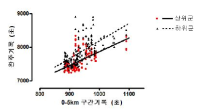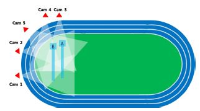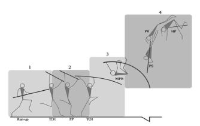The purpose of this study was to examine whether β-alanine ingestion for 8 weeks can regulate isokinetic knee strength, and 3km record in middle-long distance woman cyclists. Fourteen middle-long woman cyclists participated in this study and were divided into two groups; training group with beta-alanine ingestion and training group with placebo ingestion. All subjects took in beta-alanine or placebo supplement three times per a day for 8 weeks. Physical activity was evaluated by measuring the isokinetic muscular strength and 3km record before and after intervention for 8 weeks. As a results, in isokinetic test, there were significant interrelationships in peak torque of the right and left flexors at 60°/sec, peak torque of the right and left extensors at 180°/sec, peak torque of the right flexors at 180°/sec. In 3km record, result showed a significant interrelationship by groups and time. The results of present study provide evidence that beta-alanine supplement may be effective to increase physical activity and competition record in middle-long woman cyclists.

Purpose The purpose of this study was to examine the difference and consistency of kinematic variables for each athlete by selecting the official records of the world's elite female triple jumpers to evaluate the performance level. Methods Three athletes who won the prizes at the World Championships Daegu 2011 Women's Triple Jump were selected as the study subjects, and only the successful trials were used for analysis. Pearson's correlation analysis was conducted with the kinematic variables in the hop, step, and jump phase, respectively. Also, kinematic variables with statistically significant correlations between braking time and pushing time and related variables were described separately. The duty factor and support factor for the hop, step, and jump of support phases were calculated. Results The successful trials rate were 66.7% for Olha, 50% for Olga, and 83.3% for Caterine. In the last three stride distances of the approach run, Olha and Caterine had a “medium-long-short” pattern and Olga had a “long-short-medium” pattern. There was no difference in the duty factor value between hop and jump phases in the ‘hop-dominate’ technique type, but there was a difference in the jump phase in the ‘balance’ technique type, and the duty factor value in the step of both technique types was greater than that of hop and jump phases. As for the percentage of the support factor, Olha and Caterine had a characteristic that the percentage of braking time in step and jump phases was opposite. On the other hand, Olga had the same percentage for the hop and step phase, and a smaller percentage for the jump phase. Conclusion To increase the accuracy of the board touch-down, maintain a certain last stride(1SL) depending on the technique type. This consistency of the approach run increases reduces distance loss on the take-off board and increases the successful rate of each trial. The duty factor can judge both the performance level and the technique type of triple jump, and the support factor is a variable that can classify the technique types of hop, step, and jump phases. If both the relative time required for the triple jump and the variability of the support time(braking and pushing) for each phase are constant, the difference in records by trial will be small.

PURPOSE The purpose of this study is to section the stages of performance development based on the track and field athletes' performance records, derive the performance development span, which was a continuum of the development stages, and extract the psychological experience of the performance development span. METHODS In this study, 56 retired track and field athletes were provided with competition records, and 10 athletes participated in in-depth interviews. With the stage of performance development partitioned using long and short-term moving averages and regression slope in PRR, a continuous of performance development span was derived. To extract psychological experiences in the performance development span, a subject analysis was conducted after an in-depth interview. RESULTS First, the track and field athletes' performance development stage calculated short and long-term moving averages in the PRR. Based on the average difference in the regression slope of the initial 20% CPR in which the long-term moving average was not calculated, it was divided into beginning, rising, peak, and decline periods. Second, the performance development span was a continuum of the stage was of performance development, and the beginning period was 0 < PRR ≤ 7, it was a time when the competition record rises sharply. The rising period was 7 < PRR ≤ 60, which was a virtuous cycle time of growth athlete. The peak period was 60 < PRR ≤ 74, which was a time when the peak record was maintained. The decline period was 74 < PRR ≤ 100, which was a time when the competition record was downward. Third, throughout the performance development span physical intelligence of track and field athletes was based on their natural physical superiority, the technical skills rises and remains at its peak and then enters a downward trend. Competitional Intelligence aims to become personalization as it matures gradually while its competition management capability and game knowledge are immature. Psychological intelligence overcomes the initial psychological atrophy to form confidence, and after experiencing psychological burden at the peak, confidence decreases. In the environmental context, the competition record rises in the early stages, continues to rise, peaks, and enters a downward trend. CONCLUSIONS Track and field athletes' performance development span was implemented as a continuum of beginning, rising, peak, and decline periods, and the psychological experience of the performance development span formed a span of physical intelligence, competitional intelligence, psychological intelligence, and environmental context.

The purpose of this study was to examine that the reciprocal relationship between every 5km and full course running time record. In this study we extended our research scope to investigate whether any notable running time differences were existed among top level of marathoners. Comparisons were made using data which were drawn from 34 championship competitions had been held between year 2000 and year 2009 in Korea. Total 340 full time data was obtained from 340 marathoners who successfully completed their 42.195km running race, and divided into one of two categories, either upper ranked group (URG, ranked 1st~5th position in competitions they participated) or lower ranked group (LRG, ranked 6th~10th position in competitions they participated). Mean and standard deviation were calculated from SPSS (VER. 20.0), and repeated measures of ANOVA and Pearson's correlation was adopted to perform statistical analyses. There was no statistical difference of the running record during first 5km, however running time form all other 5km running sections was significantly faster in URG than LRG (p<.001). The gap of running time record between URG and LRG was getting more and more significant after 20km running. The quickest running record was found during 2nd 5km section (i.e., 5~10 km) and the each section's race time was getting drastically slower during 6th~7th 5km section running regardless of the study groups. Drawn conclusions from this study were that athletes use the strategy of deciding victory in both the beginning and the latter phase of marathon running. This implies that athletes who have the capacity, which make them run faster than others during the very beginning of marathon competition, and/or during 25~35km running sections would be the most preferable for the victory at the finish line.








[Purpose] The purpose of this study was to predict winning percentage in the Korean Basketball League(KBL) by applying the possession concept. [Methods] The model to estimate possession was utilized by formula used in NBA(National Basketball Association). Data consist of 20 seasons of the KBL (1997-2017). For data analysis, multiple regression analysis, Fisher’s Z transformation and stepwise multiple regression analysis were performed using SPSS 22.0. [Results] The result indicated that average team stats per possession had more explanatory power in predicting the KBL teams’ winning percentage than average team stats per game. The most important factor for winning in the KBL was defensive rebounds and followed by 2-point field goal percentage, steals, 3-point field goal percentage, free throw attempts, turnovers, offensive rebounds, blocked shots, free throw percentage, and assists. The results of this study provided fundamental information for the data analysis of Korean basketball games. It might be useful for basketball coaches to manage and instruct their teams. [Conclusion] Practical implications and future research direction were also suggested.

The purpose of the study was to investigate the relationship between the different kinematical variables with respect to the records and techniques performed by the participants during the 2011 Daegu IAAF World Championships Men's Pole Vault Event. Subjects chosen for the study were 8 male athletes who were selected for men's pole vault finals (highly skilled group) and 7 athletes who scored lowest record (skilled group) from the men's pole vault qualifying round. Personal best record of the each subjects were chosen to perform two dimensional (2D) and three dimensional (3D) video analyses. The data were obtained at 60 Hz with the use of five video cameras and digitizing was performed. Kinematical variables were calculated after smoothing the data using 2nd order Low-Pass Butterworth filter at cut-off frequency of 10 Hz and Independent samples t-test was performed to test any differences between two subject groups. The results: during the run-up stage, the horizontal velocity rate of the number of steps and run-up phase was obtained higher in highly skilled group than skilled group. During the take-off phase, deceleration in the horizontal velocity rate was observed in highly skilled group than skilled group. Distinct technical characteristics of distant and lower take-off of the take-off angle (angle of pole support) were also observed in highly skilled group than skilled group. During the pole bending and releasing phase, horizontal velocity was generally higher in highly skilled group than skilled group. It is considered that highly skilled group was able to jump higher as the vertical velocity during the pole bending as well as release phase was much higher in comparison to the skilled group.


PURPOSE This study theoretically explains the relationship between Keirin players’ core competencies and their performances. It also analyzes the impact of interaction between objectively identifiable core competencies and players’ efficiency toward their results, that is, the ability to convert their resources into performance. METHODS Using Python 3.11.1, 20,185 race records were collected of cyclists who competed at Gwangmyeong Velodrome in 2022 and 2023, and player efficiency was estimated using the R 4.3.1 package. Subsequently, the impact of players’ physical abilities (200 m records) on performance and player efficiency’s influence on the relationship between physical ability and performance were analyzed using Model 1 of PROCESS 4.1 Macro installed in SPSS 26.0. RESULTS First, players’ physical ability had a statistically significant impact on their performance. Specifically, the 200 m record significantly influenced the likelihood of finishing in the top 1 (coef = –.68 , p<.01 ), top 2 (coef = –.56, p<.01), and top 3 (coef = –.46, p<.01). Second, player efficiency moderated the relationship between players’ 200 m record and the likelihood of finishing within the top ranks. Specifically, the interaction term’s influence was empirically demonstrated between 200 m records and player efficiency on the likelihood of finishing within the top 1 (coef = –.47, p<.05), top 2 (coef = –.28, p<.05), and top 3 (coef = –.28, p<.05) for players with similar speeds, in that it significantly increased. CONCLUSIONS This study pioneers research that explains the relationship between players’ key competencies and performance based on resource-based theory, and it empirically demonstrates that player efficiency serves as a moderating variable in the relationship between key competencies and performance.
PURPOSE The purpose of this study was to identify the scoring patterns of male and female Korean judo athletes by weight class, based on major international competitions from 2016 to 2021. METHODS We analyzed 1,508 scoring techniques, consisting of penalty, Waza-ari, and Ippon connected techniques, from male and female Korean athletes who participated in the Grand Prix, Grand Slam, Masters, World Championships, and Olympics. Chi-squared tests were conducted to examine differences in rounds, time, results, techniques, and continent by weight class. RESULTS In terms of differences in rounds, statistically significant differences were found in the men's lightweight and women's heavyweight categories. Statistically significant differences were found in the following: regarding differences in match time, in the men's heavyweight category; regarding match results, in the men's heavyweight category; and regarding differences in technique type, in the men's middleweight and heavyweight categories and in the women's lightweight and heavyweight categories. Finally, in terms of opponent continents, significant differences were found in both men's and women's lightweight categories. CONCLUSIONS In conclusion, this study confirmed the differences in wins and losses of male and female Korean athletes according to their weight classes. Based on this, it is necessary to analyze and systematize the technology types of the world's top athletes, including Korean athletes, to improve their judo performance.
PURPOSE This study seeks to contribute to the enhancement of the performance of domestic wheelchair racers by producing 3D-printed customized gloves and verifying their application effect. METHODS A total of three male wheelchair racers who belong to the T54 and have won gold medals in the National Para Games within the last three years were selected as subjects. Each subject performed three session s of muscle activity and maximum speed measurements before and after applying a 3D-printed glove during the stroke and recovery phases of wheelchair racing, focusing on the pectoralis major (PM), triceps brachii (TB), and erector spinae (ES) muscles. To standardize the muscle activity measurement data, the relative muscle activity level (%) for each section was calculated by maximum voluntary isometric contraction (MVIC) for each subject. All maximum speeds of each round of driving were calculated by the average record for comparative analysis. In addition, to verify the effectiveness of applying the 3D-printed glove, the Wilcoxon signed rank test, which is a non-parametric test method, was performed on all measured values using SPSS 24.0. RESULTS This study derived the following results. First, a statistically significant difference was observed in the muscle activity of each major muscle before and after using the 3D-printed glove. In common, an increase in muscle activity of the PM, TB, and ES was confirmed in the stroke section, and an increase in muscle activity of the TB was confirmed in the recovery section. Second, a statistically significant difference was documented in the maximum speed before and after using the 3D-printed glove. When using 3D-printed gloves, the maximum speed increased by 4.57, 3.63, and 1.06km/h for Payer A, and by 5.9, 6.04, and 7.86km/ h for Player B. In the case of Player C, the speed increased by 6.73, 2.27, and 0.83km/h, and all three players improved their maximum speed through the 3D-printed gloves. CONCLUSIONS Our study suggests that the application of 3D-printed customized gloves can have a positive impact on the performance of wheelchair racers. If the application of 3D-printed customized equipment is extended to athletes in a wider range of sports in the future, this could significantly contribute to the improvement of performance in domestic disability sport.
The purpose of this study was to describe the epidemiology of Korean collegiate injuries during 2015. Collegiate student-athletes(n=167) in six sports (badminton, baseball, basketball, rugby, taekwondo, and volleyball) participating in all practices and games during pre-season, in-season, and post-season were tracked via the injury surveillance system(rate, location, type, and cause of musculoskeletal injury). Injury rate for 1000 athlete-exposure(AE) and 1000 time-exposure(TE) were calculated with 95% confidence intervals(CI). We captured a total of 961 injuries, a rate of 19.29/1000 AE(95% CI=18.07, 20.51) and 0.16/1000 TE(95% CI=0.15, 0.17). Commonly injured body locations were knee(17.5%, n=168), thigh(16.1%, n=155), ankle(12.1%, n=116), and finger(8.4%, n=81). Injuries were mostly diagnosed as contusion(40.1%, n=385), ligament sprain(21.1%, n=203), and laceration/abrasion/skin injury(13.5%, n=130). Common causes were contact with another athlete(44.6%, n=429), contact with moving object (12.7%, n=122), overuse/atraumatic(11.9%, n=114), and contact with non-yielding object(9.4%, n=90).